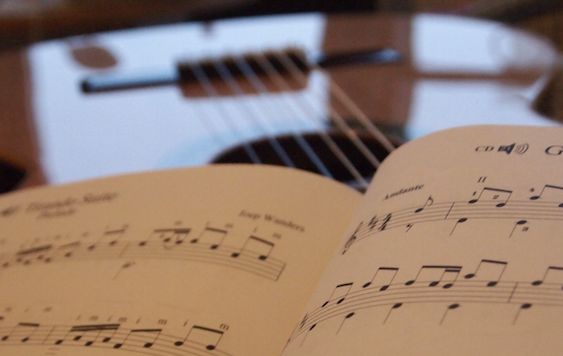Best Sight Reading Tips for Exam Success, for All Instrumentalists & Singers

Here are some of the sight reading techniques and tips that I have found to be most helpful for my students.
IMPROVE YOUR SIGHT READING WITH PREPARATION AND PRACTICE
SIGHT READ OFTEN
The more music you read and play or sing, the better you will be at sight reading. Much of the skill in sight reading is based on being able to predict what might come next in the music, so musicians who have studied lots of different pieces or songs in various styles are better equipped to find it easy to read a wide range of music. If you are a singer please don’t neglect learning to sight read – it opens up a world of new songs to you without relying on rote learning, and being able to sight read could also enable you to enjoy singing in a good choir.
ENJOY IMPROVISING MORE!
Improvising around the set of notes most often used in each key is a great idea for becoming a more confident music reader. Familiarity with the notes and chords that are likely to be used in any key will help you to predict what might come next in both ‘real’ music and in sight reading tests. You do not have to make up amazing music when you improvise – just begin by doodling around with the notes that you would find in any particular key, for example in the key of D Major you could make up tunes that start and end on D, remembering to use an F# and a C#. Pianists could explore the chords most likely to be included in that key, which are usually the key chord (in this case D major), the chord a fifth above it (in this key, A major) and the chord a fourth above it (in this key G major).
IMPROVE YOUR SIGHT READING WITH THE MUSIC EXAM IN MIND
CHECK THE KEY SIGNATURE AND CONFIRM BY LOOKING AT THE FINAL NOTE, WHICH WILL BE THE KEYNOTE
If you are unsure about key signatures, take a look at this short video explaining the circle of fifths. In an examination, sight reading tests always include the keynote in the final bar, for example a piece in the key of G major (F# key signature) will have a G in the last bar. It’s useful to check that final bar because one sharp could also mean E minor and, in this case, the last bar would contain an E.
CHECK THE TIME SIGNATURE
The top number shows how many beats in a bar and the bottom number tells you what kind of beat it is so, for example, 3/4 time means 3 crotchet beats in every bar (UK terminology), or 3 quarter notes in every bar (USA terminology). Check that you understand the meaning of 6/8 time. Don’t just look at the time signature – feel it at a suitable pace in relation to the music in the test. For example, if the music looks like a waltz you’ll need to give it a dance-like feel.
FIND THE RIGHT STARTING POSITION
This applies particularly to beginner pianists; before you begin to study the piece it’s helpful to rest your fingers on the keys that will be used because, in the earliest grades, the hand position stays the same. If any black keys are needed, place your fingers on them so that you don’t forget them once you begin playing. It also applies to beginner violinists who need to find the right starting place for the left hand fingers.
FOCUS FIRST ON WHAT IS EASY
It’s much more positive to look for what is easy about the piece rather than just looking for isolated difficult bits. Get the general gist of the music by focusing primarily on the main elements of the music, such as the predominant rhythmic feel, the shape of the melody and the tonality (major or minor). This will help to ensure that you get most of the piece right and that you achieve some degree of fluency, even if you make the odd mistake.
LOOK FOR PATTERNS
Look for note pitch patterns, like scales and leaps of a third or a fifth; these might be repeated exactly, could be in a sequence (a phrase played a note higher or lower the second time) or could be inverted (first ascending then descending). Look for intervals between notes rather than saying the note names to yourself – that’s not necessary and will impede fluency.
Look for repeated rhythm patterns. Many early grade exam candidates focus almost entirely on the note pitches and disregard the rhythms. Remember that rhythms are just as important as notes!
READ THE MUSIC IN LITTLE CHUNKS, NOT NOTE BY NOTE
You need to make sense of the music and this is only possible if you think of the notes in relation to each other, a bit like how you read words whole rather than saying the letters first. For example, if you can see that a bar contains a scale that starts on C and ends on G, you really don’t need to read every note. Pianists should ideally prepare with both hands together – practising Right Hand and Left Hand separately could cause you to miss seeing patterns that move from one hand to the other and may prevent you from getting a secure feel for the harmonies and chord progressions at later grades.
RUN THROUGH IN YOUR HEAD HOW THE PIECE MIGHT SOUND
As you hear the piece in your head (even if approximately) keep a steady pulse, while imagining the feeling of playing the correct notes. Woodwind and brass players can touch the appropriate keys/valves and strings players can find the correct left hand fingers for the notes. Pianists – where hand position changes are needed, starting at Grade 3, move your hands at the right time to each new group of notes. Aim to get to the end of the piece in your imagination – because you are not actually playing you can think the piece through at an ideal tempo, even if you then go on to play it a little slower. Singers – listen carefully to the key chord and starting note given by the examiner as you start your preparation time and don’t be afraid to sing aloud. Remember you can sing to any sound you choose and, at later grades, singing the actual words is optional.
TRY ANY TRICKY BITS SLOWLY IF THERE IS SUFFICIENT TIME
If you have imagined performing the piece in your head, there will be less preparation time left to play or sing it right through in an exam, but your thorough preparation will mean that there is little need to do this anyway. If there is any time left, just try out any bars that stand out as being tricky. The preparation time allowed for sight reading in grade exams is normally half a minute but, if you are dyslexic, your teacher should inform the exam board at the time of the application so that you will be allowed extra time to study the sight reading before doing the test for real.
DOING THE ACTUAL TEST PIECE
Choose a speed you can manage, keeping a steady pulse, without stopping even if you make a mistake. Keep looking ahead a little and aim for fluency even if you are uncertain of a note. Give rests their full time-value – take advantage of the rests to focus on what is coming next. Create a lovely tone and don’t try to hide uncertainty by playing or singing too quietly … If in doubt, just miss it out … or make it up – yes really, because fluency is so important!
Aim for a sense of character and style as you play or sing. Notice any performance markings, such as the suggested articulation (slurs, staccato and legato) and dynamics eg loud (f) and quiet (p). A performance that shows the musical character of the piece or song will attract extra marks in an exam.
IF YOU ARE A PIANIST, TRY E-MUSIC MAESTRO ONLINE PIANO SIGHT READING!
Each grade has 100 or more pieces, in a wide range of styles that cover everything you could possibly find in a piano exam at the early grades. Try it Free!
This article first appeared on E-Music Maestro.





